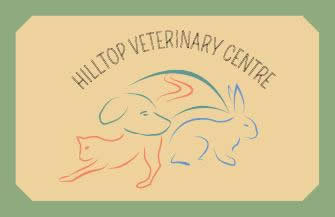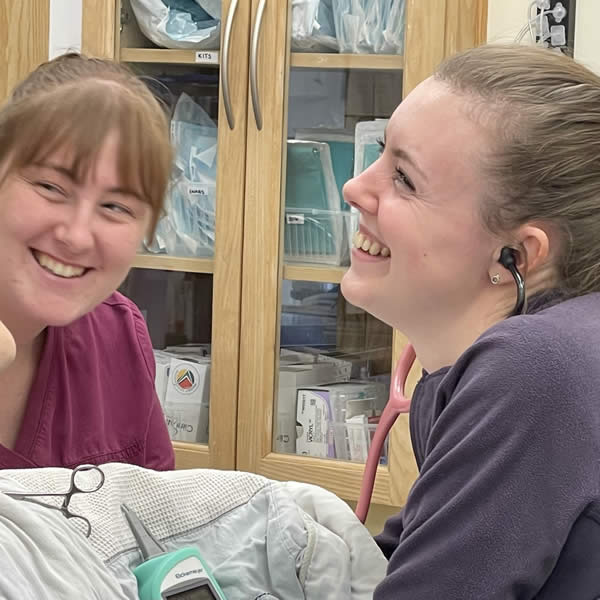There are some warning signs that suggest your pet may be suffering from heart disease. Typically dogs will show clinical signs of heart disease earlier than cats, with symptoms including:
Especially when getting up after rest ( due to fluid accumulating in the lungs, or the physical pressure of an enlarged heart resting against the windpipe & causing irritation )
Becoming tired or breathless on walks (exercise intolerance)
( this can be monitored very effectively by taking RRRs – Resting Respiratory Rate – counting the breaths taken in 15 seconds while asleep and multiplying by 4 gives the count for a minute, normally less than 30 )
( temporary failure of the blood flow to the brain )
(struggling to breathe) and cyanosis ( bluish colour to the tongue and gums due to insufficient oxygen – a more serious symptom requiring urgent veterinary attention )
Unfortunately, affected cats often present with dyspnoea as their first noticeable symptom. This is because cats can compensate for the impairment to their heart function for a very long time (they gradually change their lifestyle in subtle ways, such as resting more) and symptoms only become obvious when they reach a crisis point . This means that our feline patients are usually in a much more advanced stage of cardiac disease when they present to us, making it potentially more challenging to stabilise and treat them.
Heart disease may be congenital ( present at birth ) or develop during the animal’s lifetime. It may also be loosely divided into left sided ( affecting the left chambers – atrium and ventricle- of the heart, receiving blood from the lungs and pumping it to the body ) or right sided ( affecting the right chambers, receiving blood from the body and pumping it to the lungs ).
[/vc_wp_text][vc_custom_heading text=”Common congenital heart diseases:” font_container=”tag:h2|font_size:25|text_align:left” google_fonts=”font_family:Montserrat%3Aregular%2C700|font_style:400%20regular%3A400%3Anormal” el_class=”custom-title”][vc_single_image image=”26897″ img_size=”full”][vc_custom_heading text=”Patent ductus arteriosus:” font_container=”tag:h3|font_size:25|text_align:left” google_fonts=”font_family:Montserrat%3Aregular%2C700|font_style:400%20regular%3A400%3Anormal” el_class=”custom-title”][vc_wp_text]a blood vessel in the heart that bypasses the lungs in a foetus fails to close after birth.[/vc_wp_text][vc_custom_heading text=”Pulmonary or subaortic stenosis:” font_container=”tag:h3|font_size:25|text_align:left” google_fonts=”font_family:Montserrat%3Aregular%2C700|font_style:400%20regular%3A400%3Anormal” el_class=”custom-title”][vc_wp_text]narrowing of the one of the vessels leaving the heart, causing a reduction in outflow[/vc_wp_text][vc_custom_heading text=”Hole in the heart:” font_container=”tag:h3|font_size:25|text_align:left” google_fonts=”font_family:Montserrat%3Aregular%2C700|font_style:400%20regular%3A400%3Anormal” el_class=”custom-title”][vc_wp_text]allowing flow between left & right chambers. Many of these will spontaneously resolve as the puppy or kitten grows, & the size of the heart becomes much bigger relative to the size of the hole.[/vc_wp_text][vc_custom_heading text=”Common acquired heart diseases in dogs:” font_container=”tag:h2|font_size:25|text_align:left” google_fonts=”font_family:Montserrat%3Aregular%2C700|font_style:400%20regular%3A400%3Anormal” el_class=”custom-title”][vc_single_image image=”26892″ img_size=”full”][vc_custom_heading text=”Dilated cardiomyopathy:” font_container=”tag:h3|font_size:25|text_align:left” google_fonts=”font_family:Montserrat%3Aregular%2C700|font_style:400%20regular%3A400%3Anormal” el_class=”custom-title”][vc_wp_text]the heart muscle becomes stretched and dilated, so that it becomes less efficient at pumping blood. Large breeds are more commonly affected eg Doberman Pinschers, Boxers and Irish Wolfhounds.[/vc_wp_text][vc_custom_heading text=”Mitral valve disease:” font_container=”tag:h3|font_size:25|text_align:left” google_fonts=”font_family:Montserrat%3Aregular%2C700|font_style:400%20regular%3A400%3Anormal” el_class=”custom-title”][vc_wp_text]the valve between left atrium and left ventricle fails to form a tight seal and blood flows backwards into the left atrium when the ventricle contracts. This can be due to wear & tear on the valve or damage to the small cords that hold the valves in place. Any breed can be affected but it is more common in small breeds and seen most often in the Cavalier King Charles Spaniel. This turbulent blood flow within the heart is heard as a murmur, & we grade these from I ( so faint that they may be heard one day but not the next ) through to III( the murmur is the same volume as the heart sounds) & up to VI ( so loud that the murmur may be audible even holding the stethoscope away from the chest wall).[/vc_wp_text][vc_custom_heading text=”Common acquired heart diseases in cats:” font_container=”tag:h2|font_size:25|text_align:left” google_fonts=”font_family:Montserrat%3Aregular%2C700|font_style:400%20regular%3A400%3Anormal” el_class=”custom-title”][vc_single_image image=”26894″ img_size=”full”][vc_custom_heading text=”Arrhythmogenic right ventricular cardiomyopathy:” font_container=”tag:h3|font_size:25|text_align:left” google_fonts=”font_family:Montserrat%3Aregular%2C700|font_style:400%20regular%3A400%3Anormal” el_class=”custom-title”][vc_wp_text]the heart muscle tissue is replaced by scar tissue which impairs the heart’s electric signals and causes arrhythmias ( irregular rhythms )[/vc_wp_text][vc_custom_heading text=”Dilated cardiomyopathy:” font_container=”tag:h3|font_size:25|text_align:left” google_fonts=”font_family:Montserrat%3Aregular%2C700|font_style:400%20regular%3A400%3Anormal” el_class=”custom-title”][vc_wp_text]the heart muscle becomes stretched and dilated, so that it becomes less efficient at pumping blood.[/vc_wp_text][vc_custom_heading text=”Hypertrophic cardiomyopathy:” font_container=”tag:h3|font_size:25|text_align:left” google_fonts=”font_family:Montserrat%3Aregular%2C700|font_style:400%20regular%3A400%3Anormal” el_class=”custom-title”][vc_wp_text]progressive thickening of the left ventricular muscle which reduces the volume of the chamber. Any breed can be affected. There is a genetic predisposition. Maine Coon, British shorthair, Ragdolls and Persian cats seem to be more affected.[/vc_wp_text][vc_custom_heading text=”Diagnosis” font_container=”tag:h2|font_size:20|text_align:left” google_fonts=”font_family:Montserrat%3Aregular%2C700|font_style:400%20regular%3A400%3Anormal” el_class=”custom-title”][vc_single_image image=”26896″ img_size=”full”][vc_wp_text]The vet will take a detailed history, & perform a full clinical examination, focussing particularly on parameters affected by the heart function & circulation – gum colour, capillary refill ( checked by blanching the gum then assessing how long it takes for it to ‘pink up’ again – typically 1-2 seconds. A slow refill may mean poor circulation), assessing breathing rate & effort, listening to the chest to check heart rate & rhythm, & for the presence & degree of a murmur. Pulse quality & rate will also be checked.
Further tests may be recommended, such as a blood test to identify dilated cardiomyopathy in suspectible breeds ( ‘pro-BNP’ – checking for evidence that the heart muscle has undergone stretch), x-rays of the chest to check the heart shape & size, & the lung fields for evidence of fluid ( ‘pulmonary oedema’), an ECG and, most importantly, an ultrasound ( ‘Echocardiography’). The echo is the gold standard test as by visualising the heart in real time, we can ascertain a lot of information about its structure & function.[/vc_wp_text][vc_custom_heading text=”Treatment” font_container=”tag:h2|font_size:20|text_align:left” google_fonts=”font_family:Montserrat%3Aregular%2C700|font_style:400%20regular%3A400%3Anormal” el_class=”custom-title”][vc_single_image image=”26899″ img_size=”full”][vc_wp_text]Not all animals with a murmur require treatment. However, treatment is important for managing symptoms and slowing down the progression of heart disease, & there is evidence to suggest that animals with dilated cardiomyopathy may benefit from treatment before they develop symptoms, hence it is helpful to make a full diagnosis.
Treatment is generally medical , including use of diuretics, to alleviate fluid in the lungs or abdomen, and specific heart medications which improve contraction strength of the heart muscle & alleviate ‘back pressure’ from the circulation. Anti-clotting agents such as aspirin may also be used. And we even have patients on Viagra ( for their heart!).
The good news is that these treatments can be very helpful in prolonging life expectancy and improving quality of life in many of our patients with even relatively advanced heart disease.
Get in touch today for more info.[/vc_wp_text][/vc_column][/vc_row]





